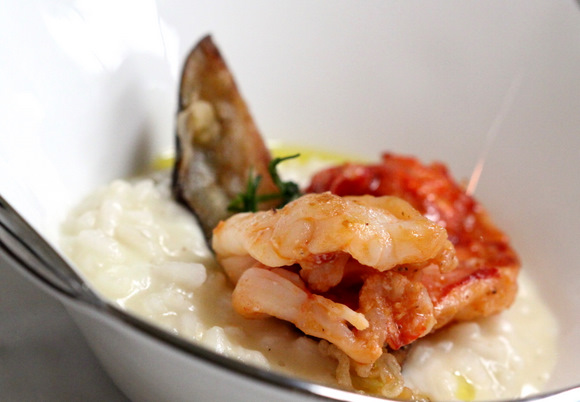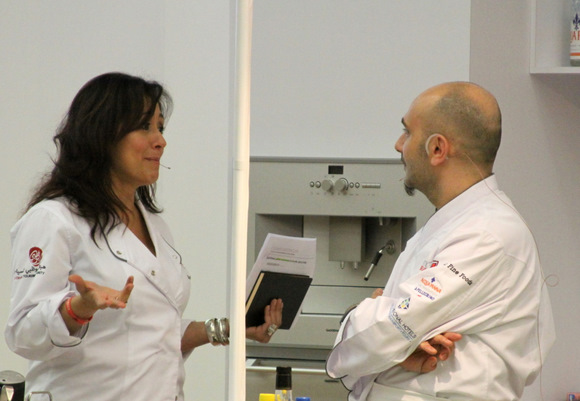 Last Tuesday, I was fed the following for FREE.
Last Tuesday, I was fed the following for FREE.


Both created by chef Tony Genovese, an Italian chef who co-owns a two Michelin starred restaurant in Rome.
When I heard about Gourmet Abu Dhabi, an event described in their souvenir booklet as, “…17 days and nights, [where] culinary aficianados will revel in an incomparable programme of chateaus and celebrity dinners, insightful masterclasses, memorable feasts,” I didn’t really enter that lunatic fit of excitement that I know I’d experience if my local Jamaican hole-in-the-wall favorite in the city, Bluefields, were to reopen. [Sincere plea: Dear Bluefield owners, please reopen. I feel this dark sinking feeling right in the pit of my tummy when I think back to your oxtail curry, and how I shall never be able to sop it up with your soft fluffy roti again.]
I normally don’t sign up for these gourmet things, not just cause they cost a bomb, but because of my whole philosophy on gourmet food in this country that I’ve ranted about discreetly on a page titled: THE RANT – My unresolved issues with food that claims to be gourmet in Dubai.
But first things first, I did visit the Gourmet Abu Dhabi website to peek at what was on the schedule, and guess what I discovered? **FREE** MASTER CLASSES BY CULINARY KINGS FROM AROUND THE WORLD! To be honest, I hadn’t heard of most of these culinary kings, but despite my ignorance and my philosophy on gourmet food in the UAE, it sounded intriguing…and did I mention, it was FREE?! So philosophy or no philosophy, if something is gourmet and free, then just close your eyes and GO FOR IT.
Chef Genovese’s restaurant in Rome is called Il Pagliaccio – ‘the clown’ And living up to that name, the chef had this playful, teasing attitude which kept us amused throughout his mini class. That, and his super endearing Italian accent…have to love that melodic, implicitly Godfatherish Italian accent. It was really something to watch him at work – blending East Asian ingredients like galangal and lemongrass or Mediterranean ones like Argan oil and almonds and apricots into his Italian dishes.

He was aided by the lovely Suzanne Husseini, a local celebrity chef, who was instrumental in asking the right questions and explaining some of the ingredients and directions to the audience in both Arabic and English.

SH: So chef, how come you use Thai ingredients in your cooking?
TG: …I was once invited to Thailand to do a cooking demonstration. When I went there…it was, it was just…
SH: You fell in love! You fell in love with the food in Thailand!
TG (grins): Yes, I fell in love. Not just with the food.
Ah those Italian men. Beware. ;)
On another note, can you believe that all the handouts for these masterclasses contain the names of the dishes, the ingredients,…and that’s it. Respected organizer-people, where are the darned directions?! This was such a tease…it’s like one of those rude algebraic tricks that your math teacher would play on you by giving you four unknown variables and only two equations to solve them with so that you’d go round and round in circles and just never end up with an answer. CHEF GENOVESE, ME WANT DIRECZIONAYS.
So rather than share step-by-step directions, which I wouldn’t have the patience to type out anyway, here’s a couple of Michelin-starred Italian lessons I came away with on risotto:
1) Italian grains are the holy Grail of risotto – arborio, carnaroli, anything that’s got a super high starch content. Any non-Italian grains are blasphemous.
2) While in Asia, we’re used to washing our rice before we boil it, there’s no need to do this for risotto. According to Suzanne, the reason we wash our rice is to get rid of some of the starch content, but in risotto, you’d want to retain that.
3) The chef just used vegetable stock for his risotto, and didn’t add any white wine. His reasoning was that he preferred to preserve the natural flavors.
 5) Pour in enough stock to just cover the rice, and when the stock reduces down, add some more. And more, until you attain that creamy risotto consistency.
5) Pour in enough stock to just cover the rice, and when the stock reduces down, add some more. And more, until you attain that creamy risotto consistency.
4) NEVER STIR THE RICE. We often feel this compulsive need to stir and stir and stir, but it is unnecessary. NEVA’ DO IT AGAIN.
5) Northern Italy likes to make its rice al dente. According to Chef Genovese, Southerners like their rice overcooked…or as politically corrected by Suzanne Husseini when there was an outcry from the Southern Italian ladies at the back of the room, they like theirs well-done.
6) If you don’t have buffalo mozzarella, don’t go for just any old mozz. *raised chef eyebrows at the disgraceful thought of using anything but buffalo mozzarella* Try going for something else like taleggio maybe (one of my personal favorites, though I’ve always treated it more like a dessert cheese)
7) You don’t have to add in every kind of cheese under the sun to make your risotto taste good. Choose one, maybe two high quality cheeses…in the words of my pizza prof Mark Bello back in New York, less is more.
8) If you want to close your risotto out Michelin star chef style, use San Pellegrino water for that last final simmer before you take the risotto off the heat.
9) If you’re tossing in tiger prawns, there’s no need to cook them before you add them to the risotto. Mix them into the simmering rice towards the end, and let the heat from the rice naturally steam the prawns. On the other hand, if you were using sweetbreads, you would need to saute them first and then place them on top of the risotto separately. Moral of the story: Know, and respect, your ingredients.
That last point is really critical. The chef was supposed to use lamb sweetbreads for this risotto, but since he couldn’t find any that met his quality standards in the city (surprise.), he opted for tiger prawns.

The dish emerged with these plump pink prawns, laying fat and happy next to crispy tempura-fried galangal and aubergines. Both were sprawled on a creamy bed of risotto that just spun out strands of cheesy goodness as you forked it out of the bowl. When I think back, there was nothing really exceptional about the dish that would make me crave it for eons to come. If someone hadn’t told me that there were Michelin stars at play here, I’d never have guessed. But not all food needs to create fireworks…this was just one of those down-to-earth comfort food with the right proportion of deep-fried and cheesy components that would make me want to curl up on a soft cushy couch and fall asleep.

The veal with galletti mushrooms, almonds and an apricot cream on the other hand didn’t quite touch my heart the same way. A lot of interesting flavors had gone in – galangal, ginger, shallots, lemongrass, argan oil…but somehow, when I sampled the dish after the class, all those flavors were lost on me amidst a chewy knob of veal with bland watery mushrooms only slightly rescued by an apricot cream drop on the side. It was so disappointing that I couldn’t even have that reaction where I’d console myself by saying, ‘oh it’s not that bad, at least it’s free!’

On a happier note, kudos to the Gourmet Abu Dhabi sponsors and the organizers, Abu Dhabi Tourism authority, for doing such a splendid job of organizing those classes and not charging anyone for them. Not only did I get to attend the classes and sample substantial portions of the chef’s creations, but I was also greeted by an entire breakfast spread in the lounge, replete with a Nespresso machine and those cream colored pyramid Tea forté tea bags that altogether made the whole affair somewhat surreal given that I didn’t have to pay a dime for it.


Don’t let Giorgio Locatelli catch him not stirring risotto! It sounds like a fantastic experience and I really appreciated your honesty here. What IS gourmet?
Interesting reading.
I guess nothing has changed since college…free food is still a no brainer!
@Sally – Such a good question, I actually googled the word gourmet to read up about different opinions. According to wikipedia (obviously I go to great lengths to get the most authoritative sources of info out there) – "Gourmet (pronounced /ɡɔrˈmeɪ/) is a cultural ideal associated with the culinary arts of fine food and drink, or haute cuisine, which is characterised by elaborate preparations and presentations of large meals of small, often quite rich courses." Ironically, I rely on the ambiance and the price list way more than the food itself to decide whether something is in the gourmet category or not. For instance, if you could get truffle mushrooms for ten bucks (hypothetically of course) from your local grocery store, I wouldn’t look at that as gourmet…but if you sold me super pricey truffle mushrooms from some schmanzy fine foods store, that would be gourmet. And if you repackaged the 10 buck mushrooms and resold them as super pricey ones from the schmanzy store, now that would be plain extortion. Doesn’t answer the question, other than confirming that gourmet can be a pretty subjective term based on people’s access to certain foods (if you had caviar everyday, would it still be gourmet for you? maybe.), exposure and price sensitivities.
@Saleem – thanks dad!
@Maeesha – I know right? If I learned one thing in college, that’d be it.